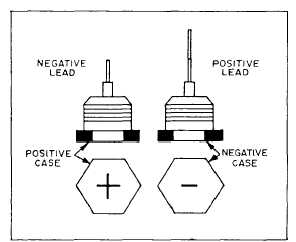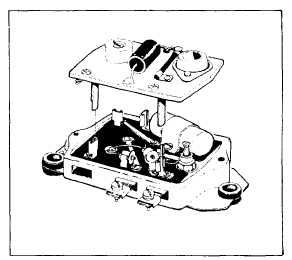higher current is required. The Y-connected alternator provides higher voltage and moderate current. The device for converting alternating current to direct current is the rectifier bridge. The rectifier bridge may be mounted internally within the alternator casing, or it may be mounted externally.
RECTIFIERS
Rectifiers of various types are manufactured for many uses. The most common type of externally mounted rectifier for automotive use is the magnesium-copper sulfide rectifier.
A rectifier mounted within the generator is the silicon-diode rectifier, as shown in figure 4-2. An advantage of the silicon-diode rectifier is its small size which permits it to be mounted internally within the casing of the alternator. The chemical composition of a diode enables current to flow through the diode in only one direction under normal conditions.
In the automotive type of alternator using silicon-diode rectifiers, six diodes are used: three positives and three negatives of the same construction, making a "full-wave bridge" rectifier.
The markings on silicon diodes vary with the alternator model and manufacturer. Some diodes are plainly marked with a (+) or (-) sign to identify their polarity (fig. 4-2). Others are marked with black or red lettering. When identifying diodes, always refer to the manufacturer's specifications.
REGULATORS
As with the dc generator, some means must be provided to regulate the electrical output of an alternator. Normally, one of the following types of regulators is used: the electromagnetic, the transistor, or the transistorized.
The electromagnetic regulator is discussed in Construction Mechanic 3 & 2.
A short description of the transistor and transistorized regulators follows.
The transistor regulator shown in figure 4-3 is a Delco-Remy model. It has two terminals, no moving parts, and limits the alternator voltage through the action of two transistors working together. This model performs the one function of controlling the alternator voltage to a preset value. From the wiring diagram shown in figure 4-4, the charging circuit consists of the alternator, regulator, battery, field relay, junction block, wiring, and either an ammeter or indicator light.

Figure 4-2.-Diodes.
Usually, you may adjust voltage internally by turning a slotted-head screw on the potentiometer which varies the connection, allowing for adjustments less than 1 volt. However, you may adjust voltage settings externally by relocating a screw in the base of the regulator. The screw contacts the series of resistors and makes a connection to ground at the point of contact.
In some transistorized regulators, a single transistor works with a conventional voltage regulator unit containing a vibrating contact point to control the alternator field current and thereby limit the alternator voltage to a preset value.
The complete charging circuit, containing a four-terminal regulator, consists of the alternator, regulator, battery, ignition switch, ammeter, and wiring,

Figure 4-3.-Transistor regulator (Delco Remy).
Continue Reading